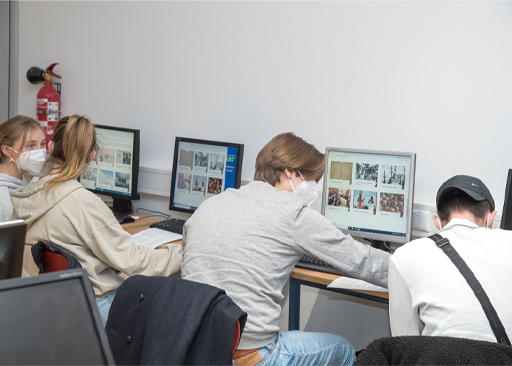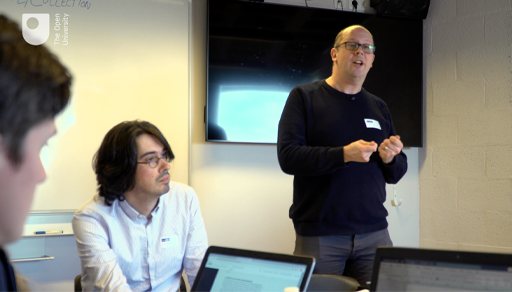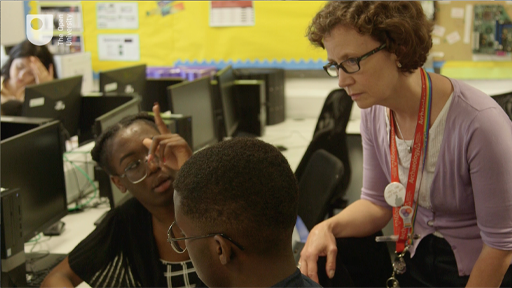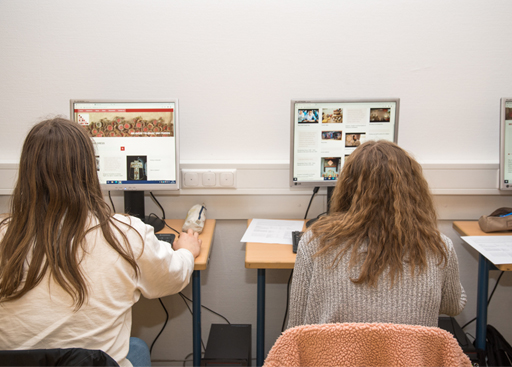4.1 Helping young people navigate and use the collection
The following IN PRACTICE activity offers suggestions on how to introduce the clippings to your young participants in the workshop and encourage them to engage with them.
IN PRACTICE: Helping young people navigate and use the collection
Approaches to the clippings collection are likely to be determined by two key considerations:
- The age and ability of the group.
- The amount of time available for the workshop or course.
If your time is limited or if the participants are younger and/or of lower ability, it may well be best for you, the teacher or leader, to make your own preliminary section of between three and six clippings and to introduce them to the group. Especially for younger teenagers, three may well be sufficient; with an older group you might make a somewhat larger selection and assign two clippings each to subgroups who would then discuss them and report back to a plenary session. Especially for clippings that include text from historic documents, some explanation and clarification of unfamiliar language may be helpful.
The website also includes (in the ‘Narratives’ section) examples of selections made for pilot workshops, which illustrate some of the thematic linkages that might be made, and how the clippings can be related to participants’ own experience. One of these selections could be adopted as a ‘package’ or, preferably, modified and developed to accommodate the situation and interests of the group. This approach requires a session of 1.5 to 2 hours in order to ensure participants understand the selected clippings and are engaging thoughtfully with them. Participants should be encouraged to consider the questions on the website associated with each clipping and might be given a printed question-sheet (as illustrated in Video 1) to prompt additional thinking and ideas.

Ideally though, you should encourage older (16+) young people to work in small groups of three or four, to browse the collection for themselves with a view to making a selection of up to five clippings that particularly engage their interest, and that they would like to study and discuss further. They could start with one of the themes identified on the website and/or use the search facility to look for clippings on a particular topic, religion, period of history, or country that interests them. Participants should be encouraged to feel free to make their own choices, while also thinking about ways in which their choices can be linked with each other and related to their own situation and experience. Young people will need sufficient time to carry out such a process effectively and to their own satisfaction. A session of at least 1.5 to 2 hours is therefore recommended for that purpose.
Activity 6
Throughout this course, you will see videos of practitioners giving advice about aspects of running a workshop. The first of these is from Professor Karel Van Nieuwenhuyse of KU Leuven, a teacher educator and member of the RETOPEA team. He discusses how to get the best educational value from the clippings, and ensure that learners engage with them in different European settings. As you watch, make notes on how you might apply his suggestions in your own situation.

Transcript: Video 3
[MUSIC PLAYING]
Discussion
Your response will depend on your own circumstances, but three message you may have picked up include:
- Select clippings likely to be most relevant to your young people.
- Allow plenty of time for discussion.
- Create a safe environment.
The next perspective is from Annie Powell, a teacher at the east London school mentioned in Activity 4. As well as giving advice on how to approach the clippings, Annie considers the practicalities of running a workshop in a formal educational setting. Even if you work in a less formal setting, Annie’s advice could still be relevant to you. As you watch make notes on the people or skills you could enlist to support your own workshop.

Transcript: Video 4
[MUSIC PLAYING]
Discussion
Annie emphasises particularly the importance of making a selection of clippings that is customised to your own setting and the aptitudes of your young people. The clippings will need to be introduced in a manner that engages the group and overcomes any initial difficulties of comprehension. She also stresses the importance of having effective support. In a school setting, this is likely to come from management; in a community group it might come from trustees, parents and volunteers.
Whatever approach to the clippings is adopted, it is important to keep in mind that the primary purpose of the workshop is to stimulate new thinking about religious toleration and peace in the present-day. Hence participants should be encouraged to draw on the clippings as a source of ideas, perhaps challenging some of their previous assumptions about the past, and not to be diverted into questions about historical and other contexts that are not addressed on the website itself.

